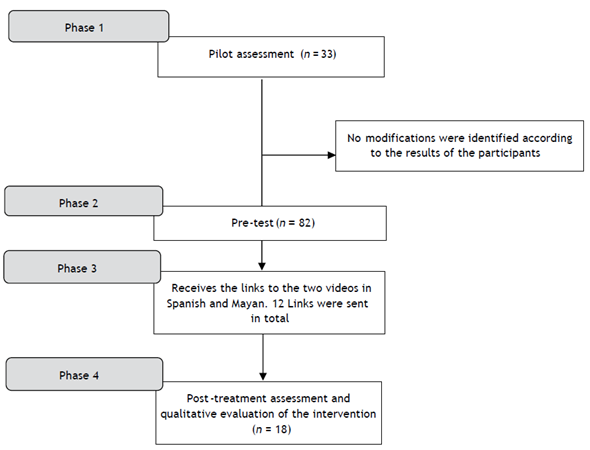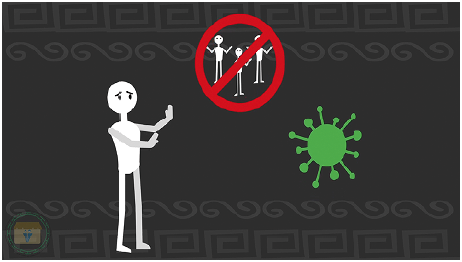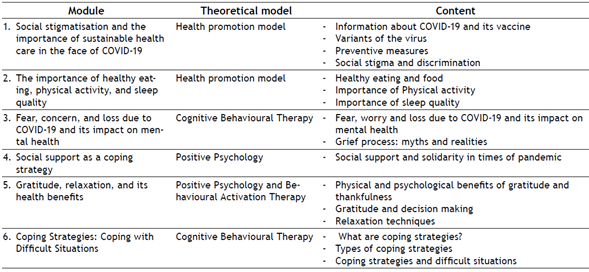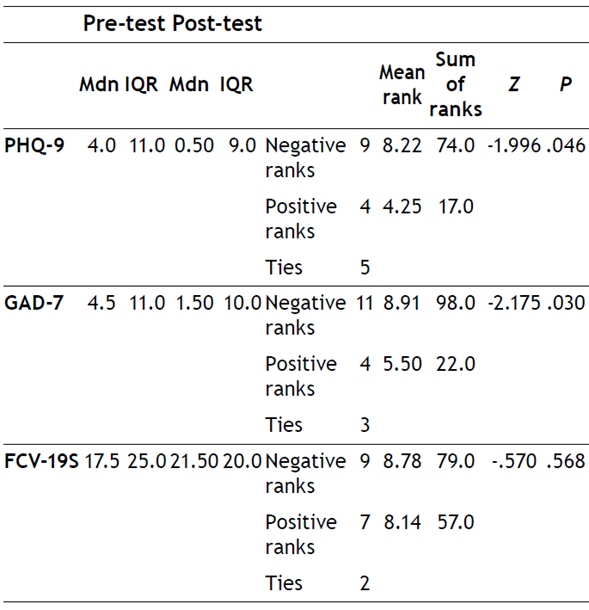The Coronavirus pandemic, first detected in December 2019, unleashed a global health crisis (Vallejo & Álvarez, 2020). Specifically, Latin America stands out with 71,346,592 confirmed cases and 1,699,598 deaths (Banco Interamerica no de Desarrollo, 2022). The effects of the pandemic have evidenced an impact on the mental health of the gener al population with an increase in anxious, depressive, and post-traumatic stress symptomatology, and a decrease in the quality of sleep (Xiong et al., 2020). Indigenous peo ple, ethnic minorities, migrant populations, impoverished and rural communities are considered social groups with a greater risk of vulnerability, a situation which is exac erbated by inequality, social injustice, and discrimination, reflecting the need for increased attention and potential solutions, in order to improve individual and collective well-being (Horbath, 2022).
In Latin America, the indigenous population is made up of approximately 58 million people throughout 800 villag es, representing 9.8% of the regional population, primarily concentrated in Mexico, Guatemala, Peru, and Bolivia (Comisión Económica para América Latina y el Caribe, 2020). In Mexico specifically, the contagion rate of COV ID-19 was 43% in the indigenous population, compared to 35.4% in the non-indigenous population, whereas the mor tality rate was 20.4% and 11%, respectively, reflecting their social vulnerability (Horbath, 2022). The Maya population, located in the southern state of Yucatan, Mexico, repre sents 2,087,175 inhabitants (Instituto Nacional de Estadísti ca, Geografía e Informática (INEGI), 2021). The mental health of over 80% of the state of Yucatan’s adult popula tion was affected (Martínez et al., 2020). As data is very limited, it is of utmost importance to collect information on the incidence and prevalence of mental health conditions in this indigenous community (Pinzón-Pérez & Vásquez, 2021). Consequently, there is a pressing need to integrate professional and psychological staff into multidisciplinary primary healthcare teams that can address the requirements of the community, as well as disseminate support tools and promote awareness campaigns for the prevention and ear ly intervention of mental health problems (Horbath, 2022).
Digital Mental Health delivers therapy through online interventions, that are evidence-based, effective, accept able, and accessible treatment options for mental health problems (Povey et al., 2016). Previous studies have focused on online interventions implemented in indigenous popula tions, such as Youth Mental Health Project, a Computerised Cognitive Behavioural Therapy programme, aimed at help ing young people with mild to moderate depression (Shep herd et al., 2015). Similarly, the AIMhi Stay Strong and Ibob bly programmes are treatments designed to reduce mental illness and stress levels experienced within the indigenous community (Povey et al., 2016).
To date, no online intervention directed at the indige nous population has been documented in Latin America. The clinical trials carried out have not focused on studying the indigenous population in their ethnic and multicultural context (Bernal & Sáez-Santiago, 2006). Therefore, there is a need to establish online therapeutic proposals to ad dress the most urgent health problems of the indigenous population.
The aim of this study was to identify the impact of a self-applied online intervention on the psychological symp toms of depression, anxiety, and fear of COVID-19 in the Maya community during the pandemic.
Method
Study Design
The study design was a prospective longitudinal quanti tative study conducted with a single group measured before and after receiving the online intervention. The interven tion consisted of 6 sessions delivered via WhatsApp. It was implemented from April to September 2021. The contents were available in both Mayan and Spanish.
This study involved four assessment phases (as shown in Figure 1).
The intervention was based on a previous study carried out by Dzul-Rosado et al. (2023), in which in-depth inter views were conducted with the indigenous community of Teabo, Yucatan, to identify needs as a basis for the design of the intervention. Researchers identified that one of the factors that led to anxiety and depressive symptoms and/or fear of COVID-19 was the lack of information related to per sonal protection strategies. Therefore, these contents were included in this intervention, as well as topics designed to promote the knowledge and acquisition of habits to prevent COVID-19 infection (social distancing, use of face masks, hand washing, and vaccination) and protective factors re lated to mental and physical health (following a healthy diet, physical activity, and maintaining quality sleep).
Participants
A non-probabilistic, intentional, subject-type sampling was conducted in the Maya indigenous Mexican population of Teabo, Yucatan. Cases that did not complete post-test evaluation (n = 64, 78%) were removed from the analysis of the impact of the intervention. There were no other missing values, except for two participants who left the open-end ed satisfaction questions unanswered and were therefore discarded for content analysis. Sociodemographic charac teristics of the sample can be found on Table 2.
Eligibility Criteria
Criteria for inclusion were: (a) to live in Teabo, Yucatan, (b) to be over 18 years old, (c) to have had prior partici pation in the community intervention project, indicating a relationship of trust between the participant and the re search team, (d) to comply with the prevention measures and not present COVID-19 infection to prevent contagion.
Exclusion criteria
Criteria for exclusion were (a) living outside of Teabo, (b) being under 18 years of age, and (c) not having access to a device to receive the intervention.
Participant Recruitment
The participants were recruited by community promot ers through direct contact and via WhatsApp. The inter vention was aimed at adults who have a smartphone and internet connection.
Setting
The population of Teabo, Yucatan, consists of approxi mately 6 921 inhabitants, and is considered 99% Maya ethnic population (INEGI, 2021). In the community overall, there are low levels of education and high levels of job insecurity. Cultural practices and ways of life are largely determined by agriculture and the milpa, a sociocultural and technical system traditionally used in the rural communities´ agri cultural system in Yucatan (Jouault et al., 2018). It is made up of a polyculture; the main species is corn, accompanied mainly by different species of beans, pumpkins, chilies, and tomatoes. The community is also dedicated to citrus farm ing, raising livestock, and handicrafts such as sewing and embroidering clothes.
Design and development of the Intervention
The intervention was developed in six stages: (1) elabo ration of the contents, (2) translation and adaptation of the contents from Spanish to the Mayan language and culture, (3) narration and recording of the contents in audio format, (4) elaboration of designs and animated videos, (5) creation of a YouTube channel, (6) sharing the web links for each module with participants on a every third day.
Stage 1. Six thematic modules were developed and writ ten by a team of experts in various areas related to health such as clinical psychologists with experience in clinical contexts such as therapy and designing and implementing online interventions, along with social workers, and nutri tionists. The contents were then subjected to review by other members of the team who were immersed in the community and familiar with its customs.
Stage 2. The contents were translated and adapted to the Mayan language by two members of the work team (CECU & FCT) who are Mayan language speakers and had had experience working on community projects.
Stage 3. The modules were narrated and recorded in audio format in Mayan (by CECU) and Spanish (by VAG).
Stage 4. The contents in text and audio format were shared with a team of design and animation students from the career of Graphic Design from the Universidad Autóno ma de Ciudad Juárez, who created sketches, illustrations, and animated videos, which were later rendered into MP4 video files.
Stage 5. A YouTube channel called Intervención Maya (Maya Intervention) was created (available here: https://www.youtube.com/channel/UC6c0P9tNWdPTNAzqMgmf G4A ). Utilising this platform made video link sharing more accessible. An example of the modules in Mayan can be found at https://www.itlasgroup.com/maya-project.aspx , as shown in Figures 2 and 3.
Stage 6. Web links corresponding to each module were shared once every three days with participants through the WhatsApp application from June 24th to September 1st, 2021, like other online interventions, which used this same means for delivering content during the COVID-19 pandemic (Yeshua-Katz et al., 2021).
Theoretical contents of the intervention
The intervention was based on the theoretical models of Health Promotion Model (HPM), Cognitive Behavioural Ther apy (CBT), Positive Psychology (PP) and Behavioural Activa tion Therapy (BAT). It consisted of six modules, containing information and practical activities. Table 1 summarises the modules.
The modules of the intervention are briefly described below:
Module 1: Social stigmatisation and the importance of sustainable health care in the face of COVID-19
Information was provided about the pandemic, the vi rus, its variants, available vaccines, and vaccine eligibility. The discrimination and social stigma experienced by people who have been sick or in contact with COVID-19 patients were also addressed. Finally, this module addressed the wi-despread misinformation surrounding the pandemic, and the relevance of following preventive measures.
Module 2: The importance of healthy eating, physical activity, and sleep quality
Information was provided regarding eating habits, healthy diet, and diet suggestions with high nutritional val ue. The relationships between our eating habits, the places where we live, and our own emotions were also discussed, in addition to the impact of the pandemic on our habits. Finally, information was shared regarding the importance of maintaining physical activity and quality sleep during the pandemic to prevent disease and promote health.
Module 3: Fear, concerns, and loss due to COVID-19 and its impact on mental health
Psychoeducation was provided regarding worry and concerns about the possible spread of COVID-19, as well as the different types of losses suffered during the pandemic. Finally, information was shared to clarify myths surrounding the grieving process.
Module 4: Social support as a coping strategy
Psychoeducation was provided to define solidarity, so cial support networks and understand their health benefits. Information about different sources of social support was included as well as activities for participants to identify their support networks.
Module 5: Gratitude, relaxation, and their health benefits
This module was focused on the practice of gratitude to persevere through difficult situations. It addressed the benefits of gratitude for physical and mental health and its impact on decision-making. Activities were suggested to help participants identify things that they might feel grate ful for. The topic of relaxation was also addressed, and par ticipants were guided through relaxation exercises.
Module 6: Coping Strategies: Coping with Difficult Situations
This module addressed different types of crises and effective coping strategies. Activities helped participants reflect on the resources they have to deal with difficult sit uations such as the COVID-19 pandemic.
There was a final reflection to conclude the interven tion. Contact information was shared with participants to seek further help from a specialist if needed.
The intervention consisted of six modules delivered every three days between sessions following the same logic presented in another online intervention with promising re sults (Dominguez-Rodriguez et al., 2023). These three days allowed the participants to practice the activities proposed in each session (see Table 1). The intervention lasted a total of 18 days.
Procedure
Due to COVID-19 protective measures, the assessment was conducted online. It had previously been established that most of the participants had a smartphone with an internet connection; therefore, the assessment and inter vention were delivered via this channel. After selecting evaluation instruments, a questionnaire was created using Google Forms. As an initial step (Phase 1, see Figure 1), a pilot evaluation was carried out with a convenience sample of 33 people from the Maya community between the ages of 17 and 55 (22 of whom were women) (M = 23.84, SD = 10.27), to identify any possible doubts regarding the ques tions. When the participants completed the questionnaire, they were asked two additional questions: (1) Were there any questions that you did not easily understand? (2) If so, please indicate which question(s). None of the participants indicated difficulties.
Subsequently, participants in the pilot study, as well as other people in the community, were asked to share the intervention materials with their contacts in the locality, including the questionnaires to measure symptoms using Google Forms (Phase 2), and the audiovisual modules with the contents of the intervention (Phase 3). Once the in tervention was completed, the post-evaluation was imple mented to assess its effectiveness (Phase 4).
Instruments
Since no psychological instruments validated with the Maya population were found, instruments validated in Span ish with the Mexican population were selected for this study to evaluate symptoms of depression, anxiety, and fear of COVID-19.
Patient Health Questionnaire (PHQ-9); Spitzer et al., 1999) was used to evaluate symptoms of depression, con taining 9 items rated on a 4-point scale ranging from 0 (not at all) to 3 (nearly every day). The scale’s total score ranges from 0 to 27 points and is obtained by adding up the scores of the items. Higher scores indicate greater severity of symptoms. PHQ-9 scores suggest four severity categories of depression: none-minimal (0-4 points), mild (5-9 points), moderate (10-14 points), moderately severe (15-19 points), and severe (20-27 points). This instrument has been validat ed in a rural Mexican sample with results indicating a good internal consistency with Cronbach’s alpha > = 0.8 (Arrieta et al., 2017).
Generalised Anxiety Disorder Scale (GAD-7). The Spanish version (García-Campayo et al., 2010) was used. The GAD-7 is a 7-item scale designed to assess the severity of symptoms of generalised anxiety disorder. Items are rat ed on a 4-point scale ranging from 0 (not at all) to 3 (near ly every day). The scale’s total score ranges from 0 to 21 points. Higher scores indicate greater severity of symptoms. GAD-7 scores suggest four categories for severity of anxie ty: minimal (0-4 points), mild (5-9 points), moderate (10-14 points), and severe (scores greater than 15). This scale has adequate reliability (Cronbach’s alpha of .94).
Fear of COVID-19 Scale (FCV-19S; Ahorsu et al., 2022) is a seven-item scale that assesses fear of COVID-19. An swers range from 1 (totally disagree) to 5 (totally agree) with final scores ranging from 7 to 35 points. Higher scores indicate greater severity of fear. The Spanish version of this scale (Huarcaya-Victoria et al., 2022) was applied. This scale has shown high reliability (Cronbach’s alpha of .82).
Sociodemographic Questionnaire. The sociodemo graphic variables evaluated were: gender, age, and level of education.
Ethical considerations
The Research Ethics Committee of the Hideyo Noguchi Regional Investigation Centre (Merida, Yucatan, Mexico) ap proved the ethical statements of this work, as a goal of the project registered with number CIE-12-2020. The partic ipants had to read and accept the online informed consent form in order to answer the psychometric evaluation and receive the intervention.
Statistical analyses
Sample characteristics at baseline were reported as frequency and percentages for qualitative variables, and as mean and standard deviations and/or median and inter quartile range for qualitative variables.
For assessing differences in sample characteristics be tween participants who completed the intervention and those who dropped out of the study, Pearson’s Chi-squared test and Mann-Whitney’s U test were used for categorical vari ables and continuous variables, respectively. To assess the impact of the intervention, mean differences between pre-and post-test measures were analysed by virtue of Wilcox on’s signed ranks test. This non-parametric test was chosen due to the reduced sample size. Analyses were performed using IBM SPSS Statistics (Version 26); statistical significance was set at 0.05. A qualitative assessment of the interven tion was conducted, but due to the length of this manu script, this will be presented in future publications.
Results
Sample description
Eighty-two people accessed the online survey; 73.6% (n = 60) were women. Mean ± SD age was 31.1 ± 16.6 years (Mdn 25.5; IQR 17.0) with participants ranging from 18 to 86 years of age. Educational attainment differed among par ticipants with 32.9% (n = 27) having “preparatoria” studies (equivalent to grades 10 to 12 in the United States edu cation system), 31.7% (n = 2 6) h igh s chool s tudies, 1 7.1% (n = 14) elementary school studies, 12.2% (n = 10) having a university degree and 6.1% (n = 5) having no schooling. The most common civil status in the sample was single (47.6%; n = 39), followed by married (35.4%; n = 29) and “civil union” (8.5%; n = 7); 62.2% of participants (n = 51) attested to being unemployed.
Mean ± SD scores for the entire sample at baseline (n = 82) were as follows: PHQ-9 3.8 ± 4.1 (Mdn = 3.0; IQR 6.0), GAD-7 4.5 ± 3.2 (Mdn = 4.0; IQR = 5.0) and fear of COVID-19 18.5 ± 7.0 (Mdn = 18.0; IQR = 9.0).
Barriers encountered by participants during the online survey
Although most participants completed the questionnaire on their own, n = 12 (14.6%) of them asked for assistance. When asked why, n = 6 (50.0%) reported difficulties using a mobile phone, n = 5 (41.7%) expressed difficulties with the Spanish language and n = 4 (33.3%) reported difficulties un derstanding the phrasing of survey items. One participant requested aid due to eyesight problems. Eight of the twelve participants who reported difficulties during the baseline assessment dropped out of the study. The remaining n = 4 completed the study in the post-treatment evaluation phase.
Analysis of non-respondents
From the total of participants who accessed the survey’s first phase (N = 82), n = 18 (22.0%) completed the study’s se-cond phase. The participants who completed the study did not differ at baseline from people who dropped out of the study. Also, no statistically significant differences were found between the two groups in terms of sex/gender, age, civil status, or educational level. Regarding employment status, participants who completed the study reported be ing unemployed to a greater extent than those who dropped out (as shown on Table 2).
Table 2 Sociodemographic characteristics and self-reported measures of participants by drop out (N = 82) a
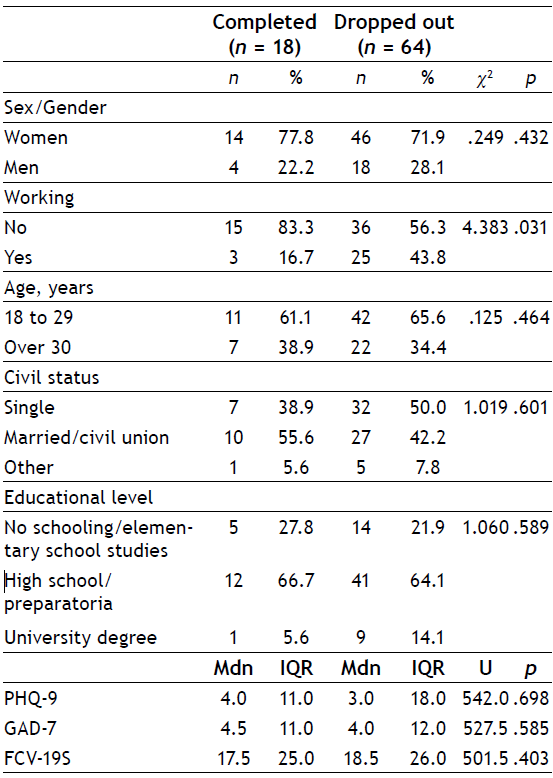
a Note: PHQ-9: Patient Health Questionnaire; GAD-7: Generalised Anxiety Disorder Scale; FCV-19S: Fear of COVID-19 Scale; Mdn: median; IQR: interquartile range; U: Mann-Whitney’s test U value; X2 Pearson’s Chi square test value
Pre-test / post-test evaluation
The results of paired Wilcoxon tests reported statisti cally significant differences between pre-test and post-test measures of the PHQ-9 and GAD-7 scales. The median difference between pretest and post-evaluation for PHQ9 was -3.50 (p = 0 .046) and was -3.00 ( p = 0.030) for GAD- 7. Size effects by virtue of Rosenthal’s R were -0.47 and -0.51, respectively, indicating medium impact. No statis tically significant differences were detected between the pre- and post-test evaluation for the FCV-19S (p = 0 .568; as shown on Table 3).
Discussion
The main objective of this study was to describe the de sign, development, and validation of an online intervention implemented with the Maya indigenous community of Tea bo, Yucatan. The goal of this intervention was to reduce the symptoms of anxiety, depression, and fear of COVID-19. Ad ditionally, the intervention promoted the reduction of social stigma surrounding people who contracted COVID-19, the ac quisition of the knowledge and habits for preventing COVID-19 infection and the promotion of mental and physical health.
The general results indicated that participants report ed statistically significant differences between pre-test and post-test measures of symptoms of depression (p = 0.046) and anxiety (p = 0.030); however, the intervention did not decrease the fear of COVID-19 (p = 0 .568). S imilar to our study, in the online intervention of Tighe et al. (2017), delivered to the indigenous population in Australia, the re-searchers measured symptoms of depression using the PHQ-9, obtaining a substantial and statistically significant reduction in depressive symptoms comparing the interven tion group with the waiting list group (t = 2.79; df = 56.9; p = 0.0072).
One factor that may have contributed to the positive results of our intervention could be related to the previous investigation of the participants’ needs through qualitative interviews conducted and reported by Dzul-Rosado et al. (2023). Once the needs of the participants were identified, the intervention was designed accordingly, with the partic ipation of leaders and academics from the Teabo commu nity, including CECU, who is part of the Maya community, speaks fluent Mayan and Spanish, and collaborated in this research and article.
Another objective of this intervention was to reduce the fear of COVID-19. However, this goal was not achieved. Although prevention measures were fundamental in limiting the spread of the disease, living in a constant state of fear over getting infected is also highly stressful and could lead to negative outcomes (Şimşir et al. 2021). Future research should focus on developing effective interventions for indig enous and non-indigenous populations in order to decrease fear in case of the appearance of future pandemics similar to COVID-19.
A limitation of this study is the absence of a control group that did not receive the intervention, which would allowed us to compare the results, as in the study of Tighe et al. (2017), conducted in non-pandemic circumstances. On the contrary, our study took place during the pandem ic and included content regarding hygienic measures and practices for preventing COVID-19 infection. Future studies in non-pandemic circumstances could be conducted follow ing stricter and more reliable methodological designs such as Randomised Controlled Trials (RCT) to increase the avail ability of literature on psychological interventions imple mented in indigenous populations.
Another limitation was not knowing whether the par ticipants received the complete intervention. We decided against using an online platform with login, as much of the population does not frequently use these systems and, in some cases, does not have an email address. Therefore, the videos for each module were uploaded to a YouTube channel, and the link was shared via WhatsApp, which was identified as a popular communication method used within the community.
Although the intervention consisted of 6 sessions in Ma yan and Spanish, plus a brief assessment, the dropout rate was high. High dropout rates are a common problem in on line interventions and have been reported in previous stud ies (Mak et al., 2018; Meyerowitz-Katz et al., 2020), being higher in unguided Internet-Based Treatments compared to guided ones (Richards & Richardson, 2012). The low adher ence to the intervention could be explained by the partic ipants’ unfamiliarity with online interventions, distrust of sharing personal information, or the idea that in being part of a collectivist culture there was more of an expectation to have direct communication with a mental health profes sional, among others. Authors such as Torous et al. (2020) have reported that completion rates for digital tools by way of remote (real) natural environments range from 44-99%.
The high drop-out rate of the intervention could be due to several reasons. First, the intervention coincided with Phase III declared by the Mexican health authorities, which implied the partial reactivation of work activities. Many people were forced to focus on obtaining basic sus tenance for their families, which occasioned less time and attachment to their cell phones. These factors, as well as economic necessity, contributed to the high percentage of dropouts in the programme.
Despite the high dropout rates, it is suggested that fu ture studies employ viable mitigation strategies, for ex ample, the integration of a human assistant to promote or guide the intervention, as well as the monitoring of moods through telephone calls or text messages.
It is important to consider that although online inter ventions have several advantages, they also imply certain ethical concerns that should be present at the moment of designing these tools, such as the protection of the mental health information of the participants; they can also widen the gap between the population, not in terms of cost but in digital literacy, which could intimidate less skillful par ticipants, among others (Hirschtritt & Insel, 2018). In the present study, we tried to manage these limitations, ensur ing that the data of the participants is safely stored and not shared with third parties, and we conducted a qualitative study to guarantee that the participants are able to use the intervention and understand how to access it. Future work should guarantee those elements and, if possible, also involve academics and industry to make more attractive digital tools for the participants (Hirschtritt & Insel, 2018) in order to provide participants with interventions that are in line with their needs and contexts. Furthermore, neces sary steps such as involving mental health workers to de sign these tools is recommended to make internet-based interventions sustainable within the mental health services offered (Williams, et al., 2019).
Conclusion
The results of this online intervention aimed at Maya adults indicate its effectiveness in reducing symptoms of de pression and anxiety but not in decreasing fear of COVID-19. To the best knowledge of the authors, this is the first online intervention implemented with an indigenous population in Latin America, not only during the COVID-19 pandemic but also prior to it. This intervention was delivered in Ma yan and Spanish, considering cultural and language factors. More low-cost and accessible interventions are needed to provide evidence-based treatments to indigenous popula tions which are more disadvantaged and vulnerable than non-indigenous individuals. This study proves that it is pos sible to deliver effective online interventions to indigenous populations and has the potential to reduce the health gap between indigenous and non-indigenous individuals1 2.













